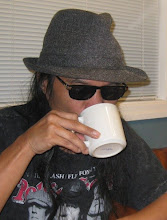Just talking about stuff. Response friends’ post on Facebook, slightly edited.
DURING typewriter days, I used to maintain my own filing system at home. Cut-out newspaper/magazine articles, neatly-catalogued photographs, some in binders. In these internet days, we “file” stuff in hard drives, thumb drives, and iCloud. Yet if you ask me what is more secured? Uh huh? I have 7 laptops, majical cellphone, dozens of thumb-drives, google docs, blogs, Yahoo and Gmail inboxes. Safe? Nope.
The scarier part of new tech or how we are forced to use electronic devices is the loss of our identity, privacy, personal us. Little example: I now write or file stuff on Google Docs. I draft all my posts. Yet even before I post them on Facebook, I already get ads that pertain to my draft/posts. They know what I am writing before they go "public" because of the "connectedness" or connectivity of whatever we write or store or file in a plugged-up computer gadget. Then, manuscripts on paper stayed where we wanted them, songs were stored where can access them before sharing etcetera.
These days? When AI finally takes us out of the "work," where are we by then? Simply consumers and buyers of whatever can be had--via the internet. 🗄📰🗄
NOTHING in this world will ever be "kept" because that is The World. That is Life. Yet it doesn't mean we will just give away what we own, especially our individual minds that we "save" in our respective work or products. That is why there is a law. Of course, the law can be inutile as well as proof of Adolf Hitler stealing many work of art and burning the rest. So those that remained, governments keep them as national treasures.
Law also in most cases benefits the corporate god over the lowly craftsperson. But I want to exist fighting them. Exist working around evil and good. Meanwhile, we can try to protect our work as another cataclysm or world war comes. Life. All those "proof" things that computer technology offers to "keep" or protect the work? Nope. It'd be easier to steal, burn and destroy them. No need for floods or nukes. Just 1 click, done. And those that they want to keep for themselves, they have them. Not ours anymore. We will just be tiny bits in a composite electronic perfection called AI.
In fact, they already did. We cannot get back or retrieve what are ours anymore. They'd say we surrendered them, willingly. You see, I don't have any problem with life's imperfection. That makes living thrilling and exciting. Floods, fires, nukes or zombie apocalypse can erase stuff. Including me. True. But I want to exist that way. Imperfect. That is the life that I knew and can afford. Not an automated existence where control is the accepted truth because they already owned us. An electronic life that breathes per preprogrammed reflex. We will be part of the machine. It just isn't me. 🦾💻🦿







